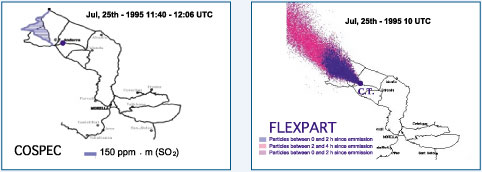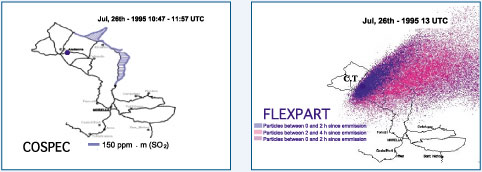
This issue in pdf Subscription Archive: Next issue: July 2005 |
|
|||||||
Air Pollution Modelling in Complex Terrain: 'Els Ports-Maestrat' Regional-Scale Studyby Jose-Luis Palau, Gorka Pérez-Landa and Millán M. Millán Characterization of atmospheric pollutant dispersion (advection and turbulent diffusion) requires a detailed description of the wind and turbulence fields, especially on complex terrain under summer conditions. Gaussian regulatory models frequently incorporate simplifications that are not valid under these circumstances. Software-engineering development and technological advances within the hardware industry have permitted the use of high-performance computing systems that are able to supply the computing power necessary for high-resolution meteorological and Lagrangian simulations. At present, the numerical simulation of atmospheric dynamics is a necessary tool for meteorological diagnosis, analysis and forecasting. At the beginning of the seventies, global models based on primitive equations represented an important development in the characterization of synoptic-scale atmospheric processes. Afterwards, the need to analyse lower-scale phenomena, together with the availability of increased computing power, resulted in the development of regional models (or limited-area models), which were capable of resolving mesoscale atmospheric features. In the Western Mediterranean Basin, characterized by strong mesoscale circulations, these regional models (executed with high-resolution meshes) are required to solve the atmospheric circulations/forcings. During the last decade, the role of traditional supercomputers and workstations has been taken over by PCs. The huge PC market has benefited from the development of hardware technology and now shows an excellent price/performance ratio when compared with workstations. The growth of free software has facilitated the development of very productive software engineering capable of efficiently interconnecting computers and parallelizing the demands of computing power. Consequently, PC clusters are now able to respond to high-performance computing needs. This has been an important advance for most atmospheric research groups, giving them more computing power for mesoscale modelling purposes and at a lower cost. One of our scientific objectives is to incorporate this new technology into the air pollution research being undertaken at our institution (at both national and international levels). One of our national research projects - the 'Els Ports-El Maestrat' project - is being used as a pilot case to fit these new technologies/methodologies to complex terrain areas with strong thermal and orographic forcings within the lower troposphere. The 'Els Ports-El Maestrat' field campaigns are sponsored by the government of the Autonomous Community of Valencia, Spain (specifically the 'Conselleria de Territori i Habitatge' and the 'Conselleria de Cultura, Educació i Sport'), and have been conducted on the south-western border of the Ebro basin (Northeast Iberian Peninsula) since November 1994. One of the objectives of these field campaigns is to monitor (both aloft and on the ground) the plume of sulfur dioxide (SO2) emitted from the 343m-tall chimney of the Andorra power plant located in Teruel (Spain). The 'Els Ports' database consists of three independent (but related) meteorological and air-quality databases, along with a fourth database composed of two different types of forest plots: forest experimental sites dominated by conifers, and plots where lichen transplant experiments have been performed. Using these four databases, we aim to understand how different (meso and synoptic) meteorological processes determine pollutant dispersion within this Iberian Peninsula basin. In addition to this, we are able to use the new technology to describe the atmospheric dispersion of SO2 emissions in summer from a power plant situated on very complex terrain in the Iberian Peninsula. Through experimentation and modelling, the studies performed within this project attempt to characterize both the advection (through the reconstruction of three-dimensional wind fields) and the turbulent dispersion present during the period of analysis. Systematic SO2 plume tracking was carried out for three days in July, by means of a vehicle equipped with a COSPEC (COrrelation SPECtrometer). This passive remote sensor utilizes solar radiation to obtain measurements of SO2 distribution, both aloft and around the emission focus. In addition, the study used a non-hydrostatic mesoscale meteorological model, MM5, coupled to a Lagrangian Particle Dispersion (LPD) Model, FLEXPART. Simulated dispersion results are generally checked against measurements of tracer-pollutant surface concentrations, with the dispersion analysis limited to the impact areas. The availability of measurements aloft enables us to verify the patterns of advection and turbulent diffusion that govern air pollution dynamics in the area. This is followed by an analysis of the cause-effect relation between the emission source and the ground-level concentration The mesoscale model uses a nested-grid configuration with five domains (100x100 grids spaced at 108, 36, 12, 4 and 1.3 km, respectively) centred over the power plant. The model predicts the wind field and turbulence parameters. The LPD model solves the turbulent wind components via the Markov process, which takes into account wind velocity variances and the three Langrangian autocorrelations. To solve the inhomogeneous turbulence in this complex terrain, the time step used is considered to be a function of the Langrangian time scale. From the point of view of advection (whole-body advection + differential advection), the coupled models were able to reproduce the typical stationary-dispersion scenarios as experimentally characterized with the COSPEC. However, a significant temporal delay was detected between the simulation and experimental measurements of the plume dispersion (see Figures 1 and 2).
From the point of view of turbulent dispersion (differential advection + turbulent diffusion), there is a significant discrepancy during the transition between dispersion scenarios (see Figure 2), between the experimental and modelled values of the horizontal distribution of plume concentration (sy, defined from the transversal axis to the average transport direction). This stands in contrast to the situation during stationary periods (see Figure 1). In the former situation, with no defined transport direction, classical dispersion parameters lose their physical meaning. In conclusion, using an adequate configuration of these two models (MM5 and FLEXPART) and with the methodology shown, it is possible to simulate/characterize the main meso-meteorological and dispersive features in complex terrain under very strong insolation conditions (where Gaussian regulatory models fail when applied to air pollution sources). Link: Please contact: |
|||||||



